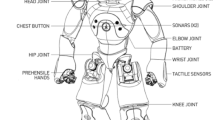Abstract
The paper presents a new control approach to robot-assisted rehabilitation for stroke patients. The control architecture is represented in terms of a hybrid system model combining a high-level and a low-level assistive controller. The high-level controller is designed to monitor the progress and safety of the rehabilitation task. The high-level controller also makes decisions on the modification of the task that might be needed for the therapy. A design of a low-level assistive controller that provides robotic assistance for an upper arm rehabilitation task and works in coordination with the proposed high-level controller is discussed. Experimental results on unimpaired participants are presented to demonstrate the efficacy of both the high-level and low-level assistive controllers.
Similar content being viewed by others
References
Matchar, D.B., Duncan, P.W.: Cost of stroke. Stroke Clin. Updates 5, 9–12 (1994)
American Heart Association: Heart and Stroke Statistical Update, http://www.Americanheart.org/statistics/stroke.htm (2006)
Taub, E.: Harnessing brain plasticity through behavioral techniques to produce new treatments in neurorehabilitation. Am. Psychol. 59(8), 692–704 (2004)
Krebs, H.I., Hogan, N., Aisen, M.L., Volpe, B.T.: Robot-aided neurorehabilitation. IEEE Trans. Rehab. Eng. 6, 75–87 (1999)
Kahn, L.E., Lum, P.S., Rymer, W.Z., Reinkensmeyer, D.J.: Robot-assisted movement training for the stroke-impaired arm: Does it matter what the robot does? J. Rehabil. Res. Dev. 43(5), 619–630 (2006)
Lum, P.S., Burgar, C.G., Van der Loos, H.F.M., Shor, P.C., Majmundar, M., Yap, R.: MIME robotic device for upper-limb neurorehabilitation in subacute stroke subjects: A follow-up study. J. Rehabil. Res. Dev. 43(5), 631–642 (2006)
Krebs, H.I., Palazzolo, J.J., Dipietro, L., Ferraro, M., Krol, J., Rannekleiv, K., Volpe, B.T., Hogan, N.: Rehabilitation robotics: Performance-based progressive robot-assisted therapy. Auton. Robots 15(1), 7–20 (2003)
Krebs, H.I., Ferraro, M., Buerger, S.P., Newbery, M.J., Makiyama, A., Sandmann, M., Lynch, D., Volpe, B.T., Hogan, N.: Rehabilitation robotics: Pilot trial of a spatial extension for MIT-Manus. Journal of NeuroEngineering and Rehabilitation 1(5), 1–15 (2004)
Kahn, L.E., Zygman, M.L., Rymer, W.Z., Reinkensmeyer, D.J.: Robot-assisted reaching exercise promotes arm movement recovery in chronic hemiparetic stroke: a randomized controlled pilot study. Journal of NeuroEngineering and Rehabilitation 3(12), 1–13 (2006)
Loureiro, R., Amirabdollahian, F., Topping, M., Driessen, B., Harwin, W.: Upper limb mediated stroke therapy – GENTLE/s approach. Auton. Robots 15, 35–51 (2003)
Taub, E., Lum, P.S., Hardin, P., Mark, V.W., Uswatte, G.: AutoCITE: Automated delivery of CI therapy with reduced effort by therapists. Stroke (36), 1301–1304 (2005)
Koutsoukos, X.D., Antsaklis, P.J., Stiver, J.A., Lemmon, M.D.: Supervisory control of hybrid systems. Proceedings of the IEEE on Special Issue on Hybrid Systems: Theory and Applications 88(7), 1026–1049 (2000)
Antsaklis, P.J., Koutsoukos, X.D.: Hybrid systems: Review and recent progress. In: Samad, T., Balas, G. (eds.) Chapter in Software-Enabled Control: Information Technologies for Dynamical Systems, pp. 1–29. IEEE Press (2003)
Antsaklis, P.J.: A brief introduction to the theory and applications of hybrid systems. Proceedings of the IEEE on Special Issue on Hybrid Systems: Theory and Applications 88(7), 879–887 (2000)
PUMA 560 Related Sites on the Internet, http://www.ee.ualberta.ca/~jasmith/puma/pumasites.html
Armstrong, B., Khatib, O., Burdick, J.: The explicit dynamic model and inertial parameters of the PUMA 560 Arm. IEEE Int. Conf. Robot. Autom. 510–518 (1986)
Craig, J. J.: Introduction to Robotics Mechanics and Control, 2nd edn. Addison-Wesley (1986)
Paul, R., Shimano, B., Mayer, G.E.: Kinematic control equations for simple manipulators. IEEE Trans. Syst. Man Cybern. 11(6), 449–455 (1981)
Erol, D., Sarkar, N.: Design and implementation of an assistive controller for rehabilitation robotic systems. Inter. J. Adv. Rob. Sys. 4(3), (2007)
Culmer, P., Jackson, A., Richardson, R., Bhakta, B., Levesley, M., Cozens, A.: An admittance control scheme for a robotic upper-limb stroke rehabilitation system. Int. Conf. On Engineering in Medicine and Biology Society 5081–5084 (2005)
Sciavicco, L., Siciliano, B.: Modeling and control of robot manipulators. McGrawHill, (1996)
Mallapragada, V., Erol, D., Sarkar, N.: A new method for force control for unknown environments. IEEE/RSJ International Conference on Intelligent Robots and Systems, 4509–4514 (2006)
Author information
Authors and Affiliations
Corresponding author
Rights and permissions
About this article
Cite this article
Erol, D., Sarkar, N. Intelligent Control for Robotic Rehabilitation after Stroke. J Intell Robot Syst 50, 341–360 (2007). https://doi.org/10.1007/s10846-007-9169-2
Received:
Accepted:
Published:
Issue Date:
DOI: https://doi.org/10.1007/s10846-007-9169-2




